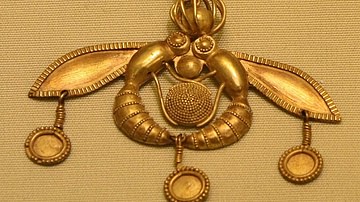Review

| Rating: | |
|---|---|
| Title: | |
| Author: | Anonymous |
| Published: | 1970 |
Published on the occasion of the opening of the exhibition of "Philippine Gold: Treasures of Forgotten Kingdoms", organized by the Asia Society, New York and the Ayala Museum in the Philippines in 2015, this eponymous exhibition catalogue introduces the public to the mysterious pre-Hispanic kingdoms of the Philippine archipelago. Edited by Asia Society Museum Curator Florina H. Capistrano-Baker, Philippine Gold is an excellent premier on the craftsmanship of the ancient Philippines.
Succinctly written in only 100 pages, Philippine Gold situates the artifacts found in the exhibition within a broad East and Southeast Asian socio-historical context. The kingdoms of the ancient Philippines were populated by advanced societies with superior metallurgical technology long before the arrival of Ferdinand Magellan and Spanish explorers in 1521 CE. The ancient Philippines laid at the intersection of trade between the Indian and Pacific Oceans. Monsoons brought traders, sailors, and missionaries to the Philippine archipelago for hundreds of years prior the arrival of the Spanish, so it is no surprise that many of the pieces on display share stylistic, iconographic, and technical similarities with distant and neighboring cultures. While this might seem obvious given prevailing monsoon weather patterns, what is less recognized is that the Philippines was and remains a center of gold mining. (The Philippines has the second largest gold deposit in the world, and you certainly can get a sense this when reading Philippine Gold!)
The text delineates first the importance of specific finds and hoards - like the 'Surigao treasure' discovered in the 1980s - and then delves into topics related to ancient metallurgy, the ancient kingdom of Butan, and the Boxer Codex from the 16th century CE, which provides pictorial evidence on pre-Hispanic costume and jewelry. The real usefulness of Philippine Gold lies in exploration and subsequent analysis of the exhibition's 117 objects: exquisite head, neck, torso, waist, and ear ornaments; ceremonial weapons; ritual retainers; and votive religious pieces attest a definite influence from ancient India and the Indianized kingdoms of Southeast Asia on many of objects profiled. (A few items exhibit limited influence from China.) Those who know nothing about the Philippines and its history will be able to appreciate the gold works on the most basic level. Those of us who already know something about Asian art and culture will also see something entirely new. These remarkable objects expand our understanding of early maritime trade and cultural exchange.
A useful map of the Philippines, a timeline of Philippine history, and an exhibition checklist with images of all artifacts are included within the catalogue. Bibliographical references in English, French, and Spanish also appear at the end of Philippine Gold, but one is surprised not to see any titles in Tagalog. Nonetheless, this list is handy for researchers aching to learn more.
AHE recommends this gorgeous catalogue to those interested in Asian history, archaeology, and art history. The images within Philippine Gold are lavish and breathtaking. Readers might be curious just to see the images alone.
Philippine Gold. Asia Society, 2015, hardcover, 100 pages, color images throughout. Available from the Asia Society for $39.95 USD.
About the Reviewer
Cite This Work
APA Style
Wiener, J. B. (2016, April 12). Philippines Gold: Treasures of Forgotten Kingdoms. World History Encyclopedia. Retrieved from https://www.worldhistory.org/review/124/philippines-gold-treasures-of-forgotten-kingdoms/
Chicago Style
Wiener, James Blake. "Philippines Gold: Treasures of Forgotten Kingdoms." World History Encyclopedia. Last modified April 12, 2016. https://www.worldhistory.org/review/124/philippines-gold-treasures-of-forgotten-kingdoms/.
MLA Style
Wiener, James Blake. "Philippines Gold: Treasures of Forgotten Kingdoms." World History Encyclopedia. World History Encyclopedia, 12 Apr 2016. Web. 09 Apr 2025.




